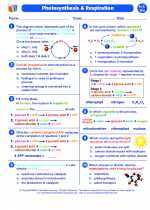Cellular Structure
Cellular structure refers to the organization and components of a cell, which is the basic structural and functional unit of all living organisms. Understanding cellular structure is fundamental to understanding the processes that occur within cells and how they contribute to the functions of living organisms.
Cell Components
Cells are composed of various components that carry out specific functions. The main components of a typical eukaryotic cell include:
- Cell Membrane: The cell membrane encloses the cell and regulates the passage of materials into and out of the cell.
- Cytoplasm: The cytoplasm is the gel-like substance within the cell where organelles are suspended.
- Nucleus: The nucleus contains the cell's genetic material (DNA) and controls the cell's activities.
- Organelles: These are specialized structures within the cell that perform specific functions, such as the endoplasmic reticulum, Golgi apparatus, mitochondria, and chloroplasts (in plant cells).
Cell Types
Cells can be broadly categorized into two types: prokaryotic and eukaryotic cells.
Prokaryotic Cells: Prokaryotic cells, such as bacteria, lack a true nucleus and membrane-bound organelles. Their genetic material is found within the nucleoid region.
Eukaryotic Cells: Eukaryotic cells, found in plants, animals, fungi, and protists, have a true nucleus enclosed within a membrane and possess membrane-bound organelles.
Cellular Functions
Cells carry out various functions that are essential for the survival of an organism. These functions include:
- Metabolism: Cells carry out metabolic processes such as respiration, photosynthesis, and protein synthesis.
- Reproduction: Cells reproduce either asexually or sexually to ensure the continuity of life.
- Transport: Cells transport molecules and ions across the cell membrane to maintain internal balance and support cellular activities.
- Communication: Cells communicate with each other through chemical signals and signaling pathways.
Study Guide
To effectively study cellular structure, consider the following study guide:
- Review the components of a eukaryotic cell and their functions.
- Compare and contrast prokaryotic and eukaryotic cells, highlighting their differences in structure and organization.
- Explore the functions of various organelles within a cell and how they contribute to cellular activities.
- Understand the processes of cell metabolism, reproduction, and communication.
- Utilize visual aids such as diagrams and animations to visualize cellular structures and processes.
By mastering the concepts of cellular structure, you will gain a deeper understanding of the fundamental unit of life and the processes that drive living organisms.
[Cellular Structure] Related Worksheets and Study Guides:
.◂Biology Worksheets and Study Guides High School. Photosynthesis and respiration

 Worksheet/Answer key
Worksheet/Answer key
 Worksheet/Answer key
Worksheet/Answer key
 Worksheet/Answer key
Worksheet/Answer key
 Vocabulary/Answer key
Vocabulary/Answer key
 Vocabulary/Answer key
Vocabulary/Answer key
